Yellowstone National Park
Yellowstone is one of the most incredible places on Earth and Scott’s favorite National Park (second place is not even close). Yellowstone is a super volcano. An eruption could be devastating for a large portion of the world, but the volcanic activity is what makes this park so incredible. From its geysers like Old Faithful to its heated pools of water like Grand Prismatic Spring. In addition to all of the sights and sounds of these geothermal features you also get to see a stunning amount of wildlife bison, elk, moose, bears, wolves, marmots, badgers, bald eagles, etc. At times it feels like you are in a zoo, but this is a very wild place, and you should ensure to give all wildlife the recommended space.
Most Recent Visit
June 2018
How to Get Here
There are many ways to fit Yellowstone into an itinerary and there are several major airports within a several hour drive of the park (Billings being the closest at 3 hours), but our favorite way to get there is to fly in Jackson Hole, Wyoming and pair this park with the Grand Tetons which are between Jackson Hole and Yellowstone. Most major airlines have a few flights each day to Jackson Hole and the pricing is actually pretty reasonable from many locations. We actually got a direct flight in from Seattle on Delta, and it only required 7,500 miles (~$150 in 2018) each one way which we jumped all over!
We would recommend spending a day or two hanging out in Jackson Hole which is a really cool small town and then spending several days hiking around Grand Teton National Park before heading to Yellowstone, but if you are solely interested in the super volcano it is only about a 1.5 hour drive to the West Thumb area or a 2 hour drive to the Old Faithful area from the Jackson airport. You will have some incredible scenery, such as the T.A. Moulton Barn below, on your drive and the Teton range is magnificent!

Trip Length
This park covers 3,500 miles – so please take your time and don’t try to fly through it in one or two days like most tourists. You need at least 5 days in this park to feel like you really got to see it. If you don’t have that kind of time – try to pick out only some of the areas we talk about below and focus on those rather than rushing through everything. You can always come back at a later time to see areas of the park you were not able to get to the first time around. Also keep in mind – it takes around 90 minutes to travel between each of the major areas below and you are likely to run into wildlife traffic jams (most likely bison related) which will slow things down even more. Moral of the story – don’t jam pack your schedule in Yellowstone as you will just set yourself up for frustration and failure and this is supposed to be your vacation!
Where to Stay
While you can stay outside the park, we would highly advise against this as you will spend a good portion of each day driving into and out of the park. West Yellowstone would be the closest – about an hour away from Old Faithful. Cody and Jackson Hole are also options, but each is about two hours away from the closest major area.
There are plenty of options inside the park – both modern and rustic depending on your price point. You just need to make sure to have a plan well in advance. Many of the lodges inside the park sell out over a year in advance!! The most convenient place to stay is in the Canyon Village as it is located at the center of the park and at the junction between the West and East sides of the park. Therefore, you can get anywhere in the park in about 90 minutes which is a huge advantage. With the convenience comes a much higher price tag though. You can easily spend several hundred dollars per night to stay in the Canyon Lodge.
Don’t want to spend that much? Consider the Lake Lodge & Cabins which is about 30 minutes south of Canyon Village and 60 minutes from the Old Faithful Area. While you can still spend a pretty penny to stay in the nicer lodge rooms here – you have the option of going with some really rustic cabins at less than $100 per night which is a steal for being inside the park and saving all that commute time. You can also stay in the Old Faithful area which has tons of lodging possibilities as well – from five star lodges/hotels to very basic rustic cabins. The one downside of staying in Old Faithful is you are in the far southwestern corner of the park and therefore have a lot of driving to do if you want to visit the other areas.
Ultimately, if you have 5 nights – we would recommend spending 3 of these in Canyon Village and the other 2 in the Old Faithful area (especially if you are flying into/out of Jackson Hole). This way you can see the northern and central portions of the park while staying at Canyon before finishing up with the southern portions of the park at Old Faithful. If you don’t mind packing up every day – you could visit and sleep in each area of the park for 1 night (Lake, Canyon, Tower/Roosevelt, Mammoth Hot Springs, and Old Faithful). This would take a lot of planning, but would save a lot of time on the roads!
What to Do
As mentioned above, Yellowstone is best done by area. For simplicity, we have broken up the park into 7 areas below. When travelling in from Jackson Hole, we believe it makes sense to go counterclockwise around the park starting in West Thumb and then moving to the Yellowstone Lake area. This will mean you end your trip at Old Faithful which is the most iconic area and will also mean a shorter drive back to the Jackson Hole airport.
Grant Village/West Thumb
Before arriving at the West Thumb parking area make a 30-minute stop into the Grant Visitor Center for an introduction to the park. You can watch a couple park videos which are always well done and also talk to a Ranger to get the latest trail reports. Trails in this area can be closed quite frequently as it is prime grizzly bear territory.
After you are done at the Visitor Center, make the short 10-minute drive to the West Thumb Geyser Basin parking lot. You may have to circle a few times as this lot is normally packed by mid-morning. Find a parking spot and get settled in as you will be spending the next few hours at this location. There are two hikes/walks we recommend here:
Yellowstone Lake Overlook Trail — 1.7 miles RT, Moderate, 1 hour
This is a great trail to get your Yellowstone experience started. It isn’t tough but does climb uphill through a burned forest and culminates in a spectacular view of Yellowstone Lake from above. If you are looking at the road from the parking lot, the trail head will be on the left and will cross the road before you start climbing. There is a good chance you will come across wildlife on this trail as well – such as the elk we ran into at the end of our hike pictured below. There is a bench at the top of the hill where you can relax for as long as you want as you overlook the beautiful Yellowstone landscape.



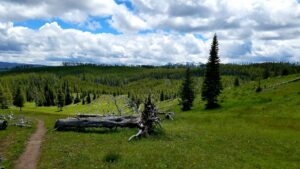
West Thumb Geyser Basin Boardwalk — 0.6 miles RT, Easy, 30 min
This is a classic boardwalk at Yellowstone. There are geysers, hot springs, mud pots, and pools everywhere. If you don’t like the smell of sulfur, you are in for a long trip because this boardwalk is pretty mild in comparison to others in the park. Some of the highlights here are Fishing Cone, Black Pool, and Perforated Pool.

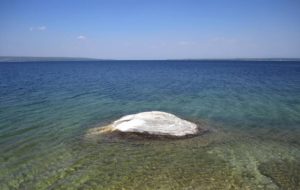


Yellowstone Lake/Fishing Bridge
The Yellowstone Lake/Fishing Bridge area encompasses a lot of space and as a result there is quite a bit to do here. Similar to West Thumb, we would recommend starting at the Fishing Bridge Visitor Center and Museum so that you can talk to the rangers and get familiar with the area. There can be trail closures here as well due to wildlife activity, so make sure you check that before you head out. We would highly recommend one hike in this area:
Storm Point Trail – 2.5 miles RT, Easy, 1.5 hours
There are many hikes in this area that will give you great views of Yellowstone Lake, but we prefer this one as you have a great chance of seeing wildlife here as bison and yellow-bellied marmots are frequently in the area. On our hike, we actually saw a skeleton of an elk strewn around the forest near the trail, so there are predators in the area as well. This hike starts in a wide-open field but quickly traverses into a forest where you will spend some time before coming out onto Storm Point with great views of Yellowstone Lake. Watch your step as there was bison scat all over on our hike.
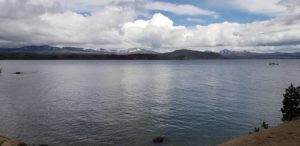
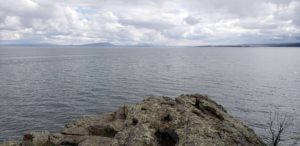
Once you are done on this hike, there are several short stops along the park road on your way to the Canyon area. You will first come across the LeHardy Rapids which are always rushing at an adrenaline building pace. Five minutes further down the road, you’ll find the Mud Volcano boardwalk which is 0.6 miles long and provides many highlights such as Sour Lake, Black Dragon’s Caldron, Dragons Mouth Spring, and Mud Volcano itself. Just a couple more minutes down the road is Sulphur Caldron which is a quick roadside stop. On the drive from Lake to Canyon you are also likely to come across several bison on or near the roadway as you pass through the Hayden Valley. Be prepared to spend some time in one of the famous bison traffic jams!




Canyon
The Canyon area is our favorite place to stay in Yellowstone as it right in the middle of the park giving you easy access to all other areas. In addition, the Yellowstone Canyon is home to both the Upper and Lower Yellowstone Falls which provide some of best pictures in the entire park. As in most areas – there is a great Visitor Center here that is worth checking out and plenty of food options as well. Also of note, this is one of the very few areas in the park you have a chance of getting any cell phone reception in case that is important to you. So what is the best way to explore the waterfalls? Well, there are quite a few options. You could choose to one of these or all of them!
Brink of the Lower Falls – 0.7 miles RT, Moderate, 1 hour
This is one of the more heavily trafficked trails in the park and will give you awesome views of the Lower Falls. It isn’t easy though. You are going to descend several hundred feet which means you have to climb up several hundred feet to get back to the parking area. Take your time and plenty of water on this hike as the views down by the Lower Falls are awesome. You will also get to experience the sheer power of these Falls as you stand just feet away from it.


Brink of the Upper Falls – 0.3 miles RT, Easy, 30 min
This is a much easier trail to handle if you are concerned about getting down to the Lower Falls. You will get to experience just as much power here from the Upper Falls.
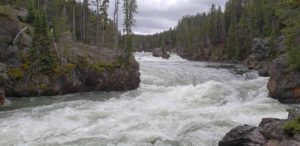
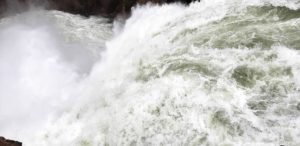
Uncle Tom’s Trail – 0.6 miles RT, Strenuous, 1 hour
This trail was closed for renovations the last time we went. But once it is re-opened, this is the most famous trail in the Canyon area. While only 0.6 miles, you will have to descend about 500 feet mostly on 300+ stairs which again means you have to re-climb those same stairs. This hike is not for the faint of heart, and you won’t get as close to the Lower Falls as you do on the Brink of the Lower Falls trail, but the views here are incredible, and it is more about the experience of the trail itself.

Artist Point
If you have seen a picture of the Lower Yellowstone Falls it is likely from Artist Point. This is arguably the most famous picture spot in the entire park, and you don’t have to hike to get there! The point is just a few hundred feet from a very busy parking lot. We highly recommend stopping here for some photos and views you won’t soon forget!
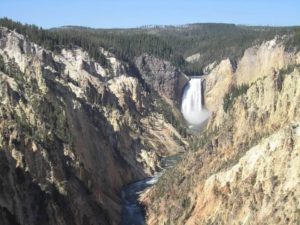

You can also spend time hiking along the North Rim Trail which will provide you with more awesome views of the Lower Falls. On your way back to the lodge area, you will come across a giant boulder dropped by a glacier long ago. You can easily spend an entire day in this area checking out the Falls and the canyon.


If you are looking for a more challenging hike – we would recommend Mt. Washburn which is up the road from the lodge about 15 minutes.
Mount Washburn Dunraven Pass – 7.0 miles RT, Strenuous, 4.5 hours
Admittedly, we have never attempted this hike as it has been closed off each time we have gone to the park. It is very snowy on this trail until late summer, so if you are going to attempt this plan your trip in late July or August. Everything we have heard about this hike is awesome including lots of wildlife sightings (primarily big horned sheep). You will have to climb about 1,350 feet so it is a strenuous hike. This is on our list of things to do next time we plan a Yellowstone vacation!
Tower-Roosevelt / Lamar Valley
If you want wildlife this area is where you are going to want to spend a lot of time. This is an under the radar portion of the park with no major sights to see, but it has a number of incredible hikes and there is literally wildlife everywhere you look. The most famous of the wildlife in this area are the wolves which we have never actually seen ourselves. There are several packs in the Lamar Valley but bring your binoculars as it is unlikely you’ll see them close to the park road. Here are some hikes we would recommend as well as some sites and wildlife photos.
Yellowstone River Picnic Area Trail – 3.8 miles RT, Moderate, 2.5 hours
This is a fantastic hike through a portion of the Lamar Valley right next to the Yellowstone River. We saw bison, pronghorn, and our first ever badger in the wild on this hike. While labeled as moderate, this was a relatively easy and enjoyable walk and instead of going out and back on the same trail. We chose to loop over onto the Specimen Ridge Trail to head back to the park road. If you want to hike at least a portion of the 17.7 mile long (one way) Specimen Ridge trail that is also highly recommended.


Trout Lake – 1.2 miles RT, Easy, 1 hour
This hike is closer to the Northeast entrance to the park than it is to the main park loop road – but you should drive out this way anyway to get a full view of all the wildlife in the Lamar Valley. If you do make it, this little hike is really worthwhile. You will walk a little uphill, but then it levels out and you have the ability to walk all the way around this lake which often has reflections of the nearby landscape. We actually couldn’t get all the way around, as several bison were laying around the trail and we were not going to press our luck!
Lamar Valley Wildlife
As we mentioned above, driving out into the Lamar Valley is certainly a worthwhile activity if you are interested in seeing wildlife. If you happen to be staying nearby, we recommend driving out here every evening to see what you can find. Bison, pronghorns, elk, bears, and wolves frequent this area along with lots of other wildlife. This is a must do in Yellowstone and many people don’t do this since it isn’t near any of the main attractions.

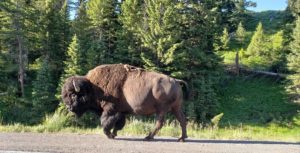


Tower Fall & Petrified Tree
As you make your way back to Tower Junction from your drive and hikes in the Lamar Valley there are two sites about 10 minutes apart from each other which are worth stopping for. Tower Fall has water cascading down 132 feet right next to the park road which provides for some good pictures. In addition, there is a nice gift shop right here in the parking lot which is worth checking out if you are in need of a souvenir. Once you are done here, make the 10-minute drive to Petrified Tree. There isn’t much to see on the surface, but then you have to consider this tree is tens of millions of years old.


Mammoth Hot Springs
Mammoth is the most historical area of the park with lots of very old buildings. It also home to several very interesting hot spring formations and tons of elk. If you go to Mammoth and don’t see at least a few elk, you are incredibly unlucky as a lot of them just hang out right in the middle of town as if the people all around them were non-existent. There are a couple of boardwalk trails here which are a must do and we would recommend at least one other hike in the area if you have time.
Mammoth Terrace Trails – 2.5 miles RT, Easy, 1.5 hours
The Upper & Lower Terrance boardwalks can be combined into one hike and represent the main attraction that most visitors stick too during their time in Mammoth. There are some stunning sites here that will leave you wondering how formations like these even come to be. To get from the lower to upper terrace on foot there will be several stairs, but we would still classify this as a relatively easy walk. If you choose, you can just walk the lower terrace and then go back to your car and drive around the Upper Terrace in your car. Parking is very limited though and it can become hard to stop and get those once in a lifetime pictures.




Beaver Ponds Loop – 5.6 miles RT, Moderate to Strenuous, 3 hours
In addition to the Upper and Lower Terrance, we recommend going off the beaten path in this area and doing the Beaver Ponds Loop. You’ll quickly realize that not many other visitors take this same approach as you are quickly on your own in the wilderness. This is a really fun hike as you will stroll through lots of meadow and forest before getting to the Beaver Ponds about halfway through the hike. You’ll also have a great view of Montana in the second half of the hike. While the name of this trail would give you the impression you are going to see lots of beavers that is actually probably the least likely animal you will encounter. Instead, you will have a chance to see elk, moose, bears, deer, and pronghorn. It was actually so quiet on his hike, we decided to start playing some music to make sure we didn’t surprise any bears along the way. At the very end of the trail, you will be dumped out into the middle of Mammoth where there are almost always elk milling about.
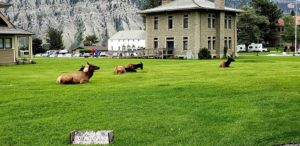



Norris Geyser Basin / Madison
This area represents a warm-up for what you are going to see in the Old Faithful area. It is the beginning of the famous Yellowstone geysers and there are plenty of hot springs to go along with them. If you travel from the Mammoth Area, you will first come across Roaring Mountain which is worth a quick stop to listen to the roaring noise (yes, it is aptly named). If you have time, take a short detour east at the Norris junction and head for the Virginia Cascades side road. It is a 15–20-minute detour but is a very nice drive along the Gibbon River with nice waterfall views as well. Once done here, head for Norris Geyser Basin and walk the boardwalk trail below.
Norris Geyser Basin – 2.25 miles RT, Easy, 2 hours
This area is actually made up of two boardwalk trails Porcelain Basin and Back Basin. We would recommend walking both of them as this will give you a great preview of what you are going to see on a grander scale in the Old Faithful area. This is also the home of Steamboat Geyser and if you are lucky enough to see this erupt you should buy a lottery ticket as it’s a tough thing to achieve. If you have time, there is a pretty cool museum in between the two boardwalks which is worth a stop. It will also have the latest eruption information on Steamboat.

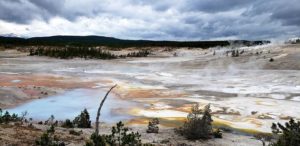


Artist Paint Pots – 1 mile RT, Easy, 1 hour
Once you have completed the Norris Geyser Basin, get back in your car and take a quick ten-minute drive down the park road and to arrive at your next stop, the Artist Paint Pots. This is worth a stop and is an easy hike to view the famous paint pots along with many other hot springs.

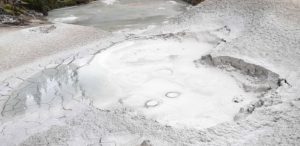
Beryl Spring / Gibbon Falls / Terrace Spring
After you complete the paint pots, you will come across several pull offs from the park road that are worthwhile: Beryl Spring, Gibbon Falls, and Terrace Spring. There isn’t much walking involved with any of these, so all are 5-10 minutes stops at most. Once you complete these, take a short detour onto Firehole Canyon Drive before heading to the Old Faithful area to conclude your epic Yellowstone experience.


Old Faithful Area
Your whole time in Yellowstone has been building up to this, the Old Faithful area. While Old Faithful is certainly the most famous geyser in the world and the main attraction here there are an incredible number of other sights and lots of trails to choose from. You can easily spend two days in this area and still have more to do. As usual start at the Visitor Center as it is going to have the predicted eruption times for all the area geysers so that you can best plan your day to see as much as you can. We would recommend a day around the Upper Geyser basin boardwalks, but before we get to there, we still have a lot to go back and do between Madison and Old Faithful, so let’s go spend a day there.
Fountain Paint Pots – 0.6 miles RT, Easy, 30 minutes
This is a nice boardwalk hike where you will get to see a lot of colorful springs, geysers, and mud pots. The coolest features here are the Silex Spring and the Fountain Paint Pots themselves for which the trail is named.


Firehole Lake Drive
As soon as you are done with the Fountain Paint Pots, get back in your car and drive across the street to the start of Firehole Lake Drive. There are some really large geysers here like Great Fountain and White Dome geysers. There is also Firehole Lake of course. This is one of the few places in Yellowstone that you can actually view geysers from the comfort of your car if you wish. Of course, you can also get out and walk which is our recommendation.
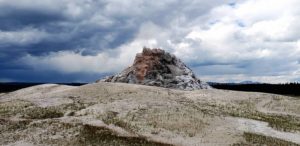

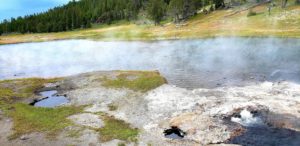

Midway Geyser Basin – 0.7 miles RT, Easy, 30 minutes and Fairy Falls – 5.0 miles RT, Easy, 3 hours
If Old Faithful or Yellowstone Lower Falls aren’t enough for you then Midway Geyser Basin provides you with another iconic photo opportunity. This basin is home to the Grand Prismatic Spring which is incredibly large and on a clear day can be seen from an overlook on the Fairy Falls trail spreading its colors in all sorts of different directions. There are two trails to do from this area and they leave from two different parking lots. First, you will want to complete the easy 0.8-mile boardwalk where you will see Excelsior Geyser Crater as well as Grand Prismatic Spring from ground level. Next, you will get back in the car and drive a few minutes down the road to the Fairy Falls trailhead parking. This is an easy walk and where you will get to see Grand Prismatic Spring from above which is oddly much more of a highlight than Fairy Falls itself!






Biscuit Basin – 0.7 miles RT, Easy, 30 minutes and Mystic Falls – 2.0 miles RT, Moderate to Strenuous, 1.5 hours
Biscuit Basin is another geyser basin with some famous features that are ‘must see’, Sapphire Pool, Black Opal Pool, and Jewel Geyser. These can be seen on an easy boardwalk hike and if you are feeling adventurous and trying to get away from the crowds you can exit the back of the boardwalk and do a 2-mile round trip hike out to Mystic Falls which is worth it if you have the time.






Black Sand Basin – 0.5 miles RT, Easy, 30 minutes
Yet another geyser basin – are you sick of them yet? We didn’t think so. Here you will find Emerald Pool, Green Spring, Rainbow Pool, Sunset Lake, and Cliff Geyser on an easy half mile boardwalk.
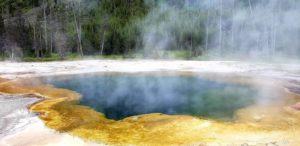



At this point, there is only one thing left to do in Yellowstone and that is to see the Upper Geyser Basin. This is a very popular spot so be prepared, it is going to be a circus on the boardwalks, especially around Old Faithful itself so try to get out early in the day to beat all of the crowds. As mentioned above, the Visitor Center will have all of the predicted eruption times for the main geysers. We always snap a picture so that we have it handy during the day.
Upper Geyser Basin & Observation Point Trail – 2.2 miles RT, Strenuous, 1.5 hours
Before you get to Upper Geyser Basin boardwalk that everyone will be on try to time a hike up to Observation Point with an Old Faithful eruption. There is nothing like seeing Old Faithful go off from several hundred feet above. It will take some work to get there, and it is a strenuous hike, but it is totally worth it if you are able.
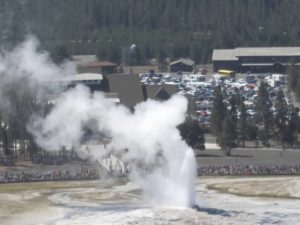

Upper Geyser Basin – 3.5 miles RT, Easy, 2.5 hours
The grand finale, the upper geyser basin boardwalk. While an easy walk, there is surprising mileage for most people here. If you were to walk every inch of the various boardwalks, trails, and loops you are going to walk about 3.5 miles. It will take several hours to get around this place, especially if you stop to try and catch an eruption at one or more of the predictable geysers. We stayed for 90+ minutes at Grand Geyser before it finally erupted. Old Faithful is the easiest to predict but many others have a range of time associated with them and as you can see with Grand, it can be quite lengthy.



